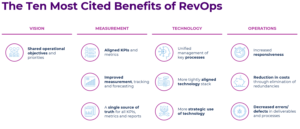Ultimately, Revenue Operations is the alignment of sales, marketing, and customer success operations [on the operational level]. Then, when that operational alignment is at its furthest point, RevOps becomes a centralized function, which subsumes marketing, sales, and customer support operations into one department.
In most B2B organizations, marketing generates leads for sales, which then closes deals and turns those leads into customers who need service and account maintenance. The unfortunate reality that most businesses face is that while marketing, sales and service teams talk about “alignment”, their operational teams are hindered with “brick walls”, and that’s where Revenue Operations (RevOps) helps.
RevOps aligns operations teams across the revenue cycle to drive growth through operational efficiency, improved effectiveness and greater insights. Organizations seeking to move forward with RevOps and those that have implemented RevOps tend to speak to the same 10 benefits. Those benefits fall broadly into four buckets: vision, measurement, technology, and operations.

RevOps benefit 1: vision
Vision is all about a shared outlook on what is important and what is necessary. Each department has different goals and objectives, and as a result that skews the focus from team to team. Even when the teams agree on the same focus areas, the way they swing those areas will also differ from one to another. Having shared goals and objectives between operations teams is critical because it allows for focus on the most important strategic initiatives for the company, instead of the individual teams.
For example, marketing operations could be interested in improving funnel diagnostics and understanding velocity and conversion rates from stage to stage. But on the other hand, sales operations is focused on rolling out a Configure Price Quote (CPQ) application, and has no interest (or bandwidth) in helping marketing. However, what marketing is trying to do requires Sales operations’ attention, so now marketing operations focus area is essentially paused.
The key benefit RevOps drives in vision is:
- Shared operational objectives and priorities
RevOps benefit 2: measurement
Measurement is about understanding current state and performance through reporting, analytics, and dashboards. The three benefits in this group all address the fact that the power of measurement comes from the insights they create and their ability to drive and alter the behavior of others. For measurement to drive maximum company value, it needs to be aligned and in support of the organization’s objectives – not just the departments. It also has to be a shared vantage point – where marketing, sales, and customer success not only agree to the key KPI’s, metrics, and reports but also how they are calculated. For example, simply agreeing that churn rate is a critical metric to track doesn’t help if each department calculates it differently.
The key benefits RevOps drives in measurement are:
- Aligned KPIs and metrics
- Improved measurement, tracking and forecasting
- A single source of truth for all KPIs, metrics and reports
RevOps benefit 3: technology
Technology here broadly encompasses using technology and business processes as a strategic enabler. The three benefits grouped here ultimately address treating the organization’s investment in technology as one holistic tech stack and not mini fiefdoms that, when combined do function, but resemble something more akin to Frankenstein than a purpose-built end-to-end process. Each department is usually responsible for their own tech stack, but no one owns the tech stack for the entire company, and this is where RevOps can help a company be more strategic with its technology overall.
The key benefits RevOps drives in technology are:
- Unified management of key processes
- More tightly aligned technology stack
- More strategic use of technology
RevOps benefit 4: operations
Operations is all about day-to-day operations administration. The key benefits cited in this group are faster cycle times, reducing costs, and decreasing error rates. RevOps allows a company to increase responsiveness in terms of priorities and project initiatives that span multiple departments because in this case, all of the operational teams work together. Responsiveness is also fostered by integrated technology planning and process management, which keeps everyone marching in the same direction. In turn, having a standardized technology stack decreases defect rates and error rates overall by having one maestro that can see how any changes or modifications will affect all of the groups in the organization.
Additionally, because of that standardization, there’s the potential for a reduction in costs. For example, marketing, sales and customer success operations could leverage one data scientist or resource who holds expertise in data visualization, versus needing to each source this expertise in their own (siloed) organization.
The key benefits RevOps drives in operations are:
- Increased responsiveness
- Reduction in costs through elimination of redundancies
- Decreased errors/defects in deliverables and processes
The biggest benefits of RevOps
These benefits do not equally stack up to one another. Some hold significantly more value than others. The two biggest areas companies benefit in by adopting RevOps are in shared operational objectives and priorities, and in the area of measurement.
- Operational objectives and priorities are shared under RevOps, and that is the number one benefit most commonly cited. This gets to the fact that when operations teams have separate goals, objectives, and priorities – along with unique incentives – operational silos are reinforced. They are more apt to point the finger and act in the best interest of their respective departments than in the best interest of the organization as a whole.
- The area of measurement is a huge benefit, mainly in regards to aligned KPI’s, improved analysis, and a single source of the truth. In a broad sense, the next three top-rated benefits focus on measurement and reporting. Having clarity to the KPIs and metrics everyone should be tracking success by is paramount. It’s also equally important to agree on how each will be counted and measured so all departments are viewing everything the same way. Unfortunately, for many organizations, though they are “data-driven” and “fact-based”, they don’t account how how data and facts do change and differ based on how and where they are pulled.
Iron Horse insight.
If you’re looking to break down the walls and drive alignment between marketing, sales and customer success operations, then RevOps should be top of mind. However, if your thinking of RevOps as a way to reduce costs and decrease defect rates -yes, it helps, especially in business processes that span departments, however, it’s not a primary benefit – and there are alternative options you should consider first.



